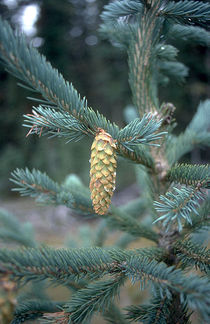
Original source: This image is Image Number 1359032 at Forestry Images, a source for forest health, natural resources and silviculture images operated by The Bugwood Network at the University of Georgia and the USDA Forest Service. Author Dave Powell, USDA Forest Service, Bugwood.org
Author: Dave Powell, USDA Forest Service, Bugwood.org

Permission: Some rights reserved
Engelmann spruce
Picea engelmannii is a medium-sized to large evergreen tree growing to 25-40 m tall, exceptionally to 65 m tall, and with a trunk diameter of up to 1.5 m. The bark is thin and scaly, flaking off in small circular plates 5-10 cm across. The crown is narrow conic in young trees, becoming cylindric in older trees. The shoots are buff-brown to orange-brown, usually densely pubescent, and with prominent pulvini. The leaves are needle-like, 15-30 mm long, rhombic in cross-section, glaucous blue-green above with several thin lines of stomata, and blue-white below with two broad bands of stomata.Picea engelmannii (Engelmann Spruce) is a species of spruce native to western North America, from central British Columbia and southwest Alberta, southwest to northern California and southeast to Arizona and New Mexico; there are also two isolated populations in northern Mexico. It is mostly a high altitude mountain tree, growing at 900-3650 m altitude, rarely lower in the northwest of the range; in many areas it reaches the alpine tree line. More
Picea engelmannii was in error. Substantiating this supposition is that, as discussed above, Engelmann named the other of the two tree species that Parry had collected, Abies menziesii. That would explain why the botanical literature of the 1870s calls both plants "Abies". More
Picea engelmannii is native to North America. Range may be expanded by planting. See states reporting Engelmann spruce (opens a new window). More
View Picea engelmannii page in the UConn Plant Database - | Back to Walk 3 | More
